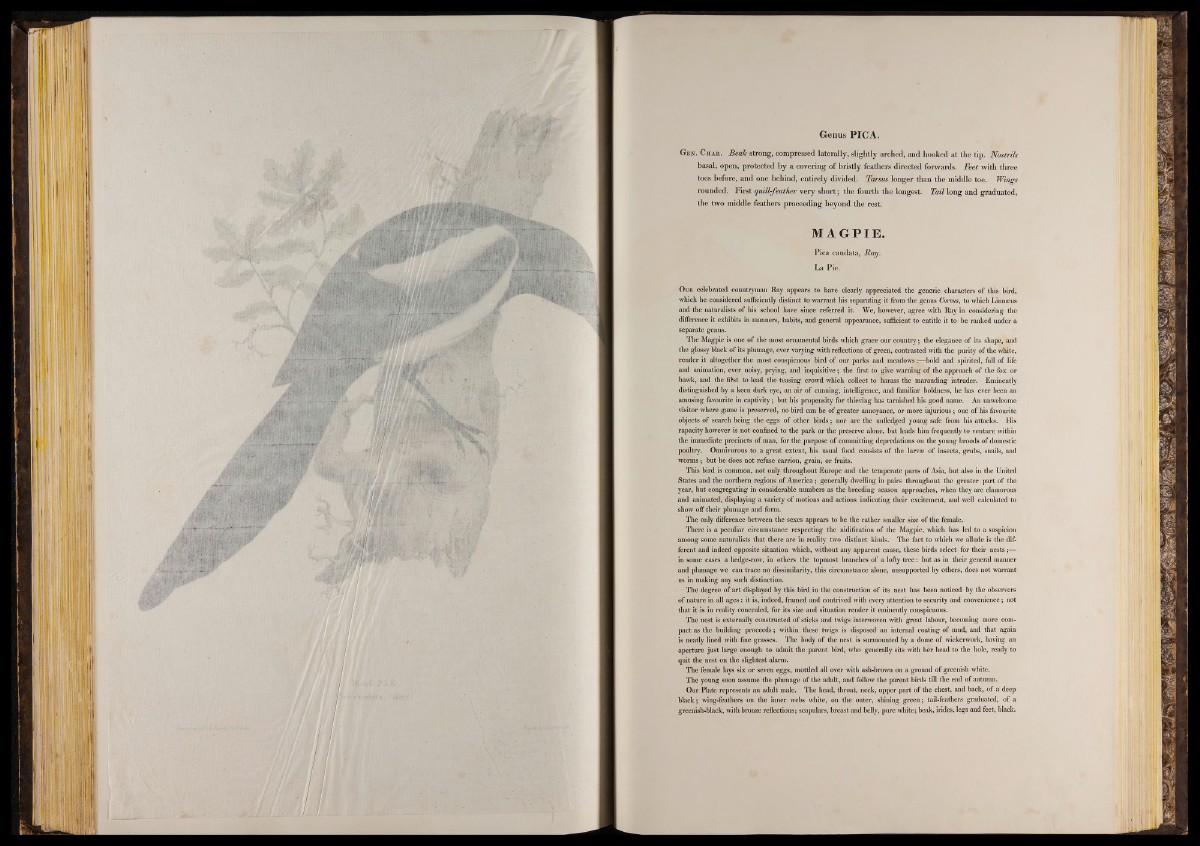
Genus PICA.
Gen. C har. B ea k strong, compressed laterally, slightly arched, and hooked at the tip. N o strils
basal, open, protected b y a covering o f b ristly feathers directed forwards. Feet with three
toes before, and one behind, entirely divided. Tarsus longer than the middle toe. Wings
rounded. First quill-feather v ery short; the fourth the longest. Tail lon g and graduated,
the two middle feathers proceeding beyond the rest.
MAGP I E .
Pica caudata, R a y .
La Pie.
Our celebrated countryman Ray appears to have clearly appreciated the generic characters o f this bird,
which he considered sufficiently distinct to warrant his separating it from the genus Cortm, to which Linnaeus
and the naturalists of his school have since referred it. We, however, agree with Ray in considering the
difference it exhibits in manners, habits, and general appearance, sufficient to entitle it to be ranked under a
separate genus.
The Magpie is one o f the most ornamental birds which grace our country; the elegance of its shape, and
the glossy black o f its plumage, ever varying with reflections of green, contrasted with the purity of the white,
render it altogether the most conspicuous bird of our parks and meadows:—bold and spirited, full of life
and animation, ever noisy, prying, and inquisitive; the first to give warning o f the approach of the fox or
hawk, and the fifst to lead the teasing crowd which collect to harass the marauding intruder. Eminently
distinguished by a keen dark eye, an air o f cunning, intelligence, and familiar boldness, he has ever been an
amusing favourite in captivity; but his propensity for thieving has tarnished his good name. An unwelcome
visitor where game is preserved, no bird can be of greater annoyance, or more injurious; one of his favourite
objects of search being the eggs of other birds; nor are the unfledged young safe from his attacks. His
rapacity however is not confined to the park or the preserve alone, but leads him frequently to venture within
the immediate precincts o f man, for the purpose of committing depredations on the young broods of domestic
poultry. Omnivorous to a great extent, his usual food consists o f the larvae o f insects, grubs, snails, and
worms; but he does not refuse carrion, grain, or fruits.
This bird is common, not only throughout Europe and the temperate parts o f Asia, but also in the United
States and the northern regions of America; generally dwelling in pairs throughout the greater part o f the
year, but congregating in considerable numbers as the breeding season approaches, when they are clamorous
and animated, displaying a variety o f motions and actions indicating their excitement, and well calculated to
show off their plumage and form.
The only difference between the sexes appears to be the rather smaller size of the female.
There is a peculiar circumstance respecting the nidification o f the Magpie, which has led to a suspicion
among some naturalists that there are in reality two distinct kinds. The fact to which we allude is the different
and indeed opposite situation which, without any apparent cause, these birds select for their nests ; - 9
in some cases a hedge-row, in others the topmost branches o f a lofty tree: but as in their general manner
and plumage we can trace no dissimilarity, this circumstance alone, unsupported by others, does not warrant
us in making any such distinction.
The degree of art displayed by this bird in the construction of its nest has been noticed by the observers
of nature in all ages: it is, indeed, framed and contrived with every attention to security and convenience; not
that it is in reality concealed, for its size and situation render it eminently conspicuous.
The nest is externally constructed o f sticks and twigs interwoven with great labour, becoming more compact
as the building proceeds; within these twigs is disposed an internal coating of mud, and that again
is neatly lined with fine grasses. The body of the nest is surmounted by a dome of wickerwork, having an
aperture just large enough to admit the parent bird, who generally sits with her head to the hole, ready to
quit the nest on the slightest alarm.
The female lays six or seven eggs, mottled all over with ash-brown on a ground o f greenish white.
The young soon assume the plumage of the adult, and follow the parent birds till the end of autumn.
Our Plate represents an adult male. The head, throat, neck, upper part of the chest, and back, o f a deep
black; wing-feathers on the inner webs white, on the outer, shining green; tail-feathers graduated, o f a
greenish-black, with bronze reflections; scapulars, breast and belly, pure white; beak, irides, legs and feet, black.